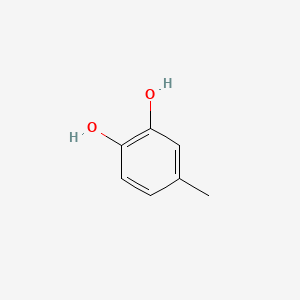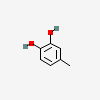4-Methylcatechol
- 4-Methylcatechol
- 452-86-8
- 4-methylbenzene-1,2-diol
- 3,4-Dihydroxytoluene
- Homocatechol
- Create:2004-09-16
- Modify:2025-01-18

- 3,4-dihydroxytoluene
- 4-methylcatechol
- 4-Methylcatechol
- 452-86-8
- 4-methylbenzene-1,2-diol
- 3,4-Dihydroxytoluene
- Homocatechol
- p-Methylcatechol
- 4-Methyl-1,2-benzenediol
- Homopyrocatechol
- 4-METHYLPYROCATECHOL
- Toluene-3,4-diol
- 1,2-Dihydroxy-4-methylbenzene
- p-Methylpyrocatechol
- 1,2-Benzenediol, 4-methyl-
- 4-Methyl-1,2-dihydroxybenzene
- Pyrocatechol, 4-methyl-
- 2-Hydroxy-4-methylphenol
- CHEBI:17254
- NSC 17489
- CCRIS 3333
- 1-Methyl-3,4-dihydroxybenzene
- UNII-12GLI7JGB3
- EINECS 207-214-5
- 12GLI7JGB3
- BRN 0636512
- DTXSID5020861
- MFCD00002205
- NSC-17489
- METHYL CATECHOL, 4-
- DTXCID30861
- CHEMBL158766
- HMDB00873
- 5-methylcatechol
- DROXIDOPA METABOLITE (3,4-DIHYDROXYTOLUENE)
- MCT
- 4-Methylcatehol
- 4-Metylcatechol
- 4-methyl catechol
- 4-methyl-catechol
- 4-methyl pyrocatechol
- 4-methyl-Pyrocatechol
- 83719-41-9
- 4k7n
- bmse000475
- Epitope ID:150928
- 4-methyl-benzene-1,2-diol
- SCHEMBL12388
- 4-Methylcatechol, >=95%
- MLS001066329
- 4-Methylbenzene-1,2-diol #
- 1,2-dihydroxy-5-methylbenzene
- 4-methyl-1,2-dihydroxy benzene
- HMS3886M12
- NSC17489
- Tox21_200632
- BDBM50548723
- c0126
- s5616
- AKOS000121479
- CCG-266087
- CS-W013530
- DB04120
- HY-W012814
- NCGC00248773-01
- NCGC00258186-01
- AC-12438
- AS-11944
- CAS-452-86-8
- SMR000471857
- SY012747
- DB-051291
- M0413
- NS00015292
- EN300-21094
- C06730
- D70562
- W-106144
- Q15303189
- F0001-1227
- Z104490128
- InChI=1/C7H8O2/c1-5-2-3-6(8)7(9)4-5/h2-4,8-9H,1H
268.0 100
180.0 62.86
149.0 58.16
179.0 54.65
165.0 48.05
268 100
180 62.86
149 58.16
179 54.65
165 48.05
107.031 100
125.005 55.09
79.111 18.63
77.135 4.66
65.00242 100
49.00875 78.50
122.03631 48.50
41.0031 19.60
108.0192 4.90
123.0451 100
122.03731 7.90
108.02173 3.70
105.03464 1.10
95.05029 0.70
69.06998 100
97.06485 59
79.05425 24.70
67.05443 4.90
125.05978 4.70
122.038887 100
108.021744 23.88
108.024673 21.68
123.045311 16.28
123.048439 14.29
123.043884 100
124.047256 6.91
95.012436 5.84
66.996376 3.35
134.925171 3.14
- Tobacco Smoke (part of)
- Stevia rebaudiuna Leaf (part of)

H302 (11.9%): Harmful if swallowed [Warning Acute toxicity, oral]
H312 (10.2%): Harmful in contact with skin [Warning Acute toxicity, dermal]
H315 (100%): Causes skin irritation [Warning Skin corrosion/irritation]
H319 (100%): Causes serious eye irritation [Warning Serious eye damage/eye irritation]
H335 (98.3%): May cause respiratory irritation [Warning Specific target organ toxicity, single exposure; Respiratory tract irritation]
P261, P264, P264+P265, P270, P271, P280, P301+P317, P302+P352, P304+P340, P305+P351+P338, P317, P319, P321, P330, P332+P317, P337+P317, P362+P364, P403+P233, P405, and P501
(The corresponding statement to each P-code can be found at the GHS Classification page.)
Aggregated GHS information provided per 59 reports by companies from 8 notifications to the ECHA C&L Inventory. Each notification may be associated with multiple companies.
Information may vary between notifications depending on impurities, additives, and other factors. The percentage value in parenthesis indicates the notified classification ratio from companies that provide hazard codes. Only hazard codes with percentage values above 10% are shown.
Acute Tox. 4 (11.9%)
Acute Tox. 4 (10.2%)
Skin Irrit. 2 (100%)
Eye Irrit. 2A (100%)
STOT SE 3 (98.3%)
Silke Matysik, Caroline Ivanne Le Roy, Gerhard Liebisch, Sandrine Paule Claus. Metabolomics of fecal samples: A practical consideration. Trends in Food Science & Technology. Vol. 57, Part B, Nov. 2016, p.244-255: http://www.sciencedirect.com/science/article/pii/S0924224416301984
Geigy Scientific Tables, 8th Rev edition, pp. 165-177. Edited by C. Lentner, West Cadwell, N.J.: Medical education Div., Ciba-Geigy Corp., Basel, Switzerland c1981-1992.
Patents are available for this chemical structure:
https://patentscope.wipo.int/search/en/result.jsf?inchikey=ZBCATMYQYDCTIZ-UHFFFAOYSA-N
- CAS Common ChemistryLICENSEThe data from CAS Common Chemistry is provided under a CC-BY-NC 4.0 license, unless otherwise stated.https://creativecommons.org/licenses/by-nc/4.0/4-Methylcatecholhttps://commonchemistry.cas.org/detail?cas_rn=452-86-8
- ChemIDplusChemIDplus Chemical Information Classificationhttps://pubchem.ncbi.nlm.nih.gov/source/ChemIDplus
- DrugBankLICENSECreative Common's Attribution-NonCommercial 4.0 International License (http://creativecommons.org/licenses/by-nc/4.0/legalcode)https://www.drugbank.ca/legal/terms_of_use4-Methyl-1,2-Benzenediolhttps://www.drugbank.ca/drugs/DB04120
- DTP/NCILICENSEUnless otherwise indicated, all text within NCI products is free of copyright and may be reused without our permission. Credit the National Cancer Institute as the source.https://www.cancer.gov/policies/copyright-reuse
- EPA DSSTox4-Methylcatecholhttps://comptox.epa.gov/dashboard/DTXSID5020861CompTox Chemicals Dashboard Chemical Listshttps://comptox.epa.gov/dashboard/chemical-lists/
- European Chemicals Agency (ECHA)LICENSEUse of the information, documents and data from the ECHA website is subject to the terms and conditions of this Legal Notice, and subject to other binding limitations provided for under applicable law, the information, documents and data made available on the ECHA website may be reproduced, distributed and/or used, totally or in part, for non-commercial purposes provided that ECHA is acknowledged as the source: "Source: European Chemicals Agency, http://echa.europa.eu/". Such acknowledgement must be included in each copy of the material. ECHA permits and encourages organisations and individuals to create links to the ECHA website under the following cumulative conditions: Links can only be made to webpages that provide a link to the Legal Notice page.https://echa.europa.eu/web/guest/legal-notice4-methylpyrocatecholhttps://echa.europa.eu/substance-information/-/substanceinfo/100.006.5594-methylpyrocatechol (EC: 207-214-5)https://echa.europa.eu/information-on-chemicals/cl-inventory-database/-/discli/details/41889
- FDA Global Substance Registration System (GSRS)LICENSEUnless otherwise noted, the contents of the FDA website (www.fda.gov), both text and graphics, are not copyrighted. They are in the public domain and may be republished, reprinted and otherwise used freely by anyone without the need to obtain permission from FDA. Credit to the U.S. Food and Drug Administration as the source is appreciated but not required.https://www.fda.gov/about-fda/about-website/website-policies#linking4-METHYLCATECHOLhttps://gsrs.ncats.nih.gov/ginas/app/beta/substances/12GLI7JGB3
- Human Metabolome Database (HMDB)LICENSEHMDB is offered to the public as a freely available resource. Use and re-distribution of the data, in whole or in part, for commercial purposes requires explicit permission of the authors and explicit acknowledgment of the source material (HMDB) and the original publication (see the HMDB citing page). We ask that users who download significant portions of the database cite the HMDB paper in any resulting publications.http://www.hmdb.ca/citing4-Methylcatecholhttp://www.hmdb.ca/metabolites/HMDB0000873HMDB0000873_cms_31786https://hmdb.ca/metabolites/HMDB0000873#spectra
- New Zealand Environmental Protection Authority (EPA)LICENSEThis work is licensed under the Creative Commons Attribution-ShareAlike 4.0 International licence.https://www.epa.govt.nz/about-this-site/general-copyright-statement/
- CCSbaseCCSbase Classificationhttps://ccsbase.net/
- NORMAN Suspect List ExchangeLICENSEData: CC-BY 4.0; Code (hosted by ECI, LCSB): Artistic-2.0https://creativecommons.org/licenses/by/4.0/4-MethylcatecholNORMAN Suspect List Exchange Classificationhttps://www.norman-network.com/nds/SLE/
- ChEBI4-methylcatecholhttps://www.ebi.ac.uk/chebi/searchId.do?chebiId=CHEBI:17254
- LOTUS - the natural products occurrence databaseLICENSEThe code for LOTUS is released under the GNU General Public License v3.0.https://lotus.nprod.net/4-Methylcatecholhttps://www.wikidata.org/wiki/Q15303189LOTUS Treehttps://lotus.naturalproducts.net/
- ChEMBLLICENSEAccess to the web interface of ChEMBL is made under the EBI's Terms of Use (http://www.ebi.ac.uk/Information/termsofuse.html). The ChEMBL data is made available on a Creative Commons Attribution-Share Alike 3.0 Unported License (http://creativecommons.org/licenses/by-sa/3.0/).http://www.ebi.ac.uk/Information/termsofuse.htmlChEMBL Protein Target Treehttps://www.ebi.ac.uk/chembl/g/#browse/targets
- ClinicalTrials.govLICENSEThe ClinicalTrials.gov data carry an international copyright outside the United States and its Territories or Possessions. Some ClinicalTrials.gov data may be subject to the copyright of third parties; you should consult these entities for any additional terms of use.https://clinicaltrials.gov/ct2/about-site/terms-conditions#Use
- Comparative Toxicogenomics Database (CTD)LICENSEIt is to be used only for research and educational purposes. Any reproduction or use for commercial purpose is prohibited without the prior express written permission of NC State University.http://ctdbase.org/about/legal.jsp4-methylcatecholhttps://ctdbase.org/detail.go?type=chem&acc=C018599
- FooDBLICENSEFooDB is offered to the public as a freely available resource. Use and re-distribution of the data, in whole or in part, for commercial purposes requires explicit permission of the authors and explicit acknowledgment of the source material (FooDB) and the original publication.https://foodb.ca/about4-Methyl-1,2-benzenediolhttps://foodb.ca/compounds/FDB008861
- Haz-Map, Information on Hazardous Chemicals and Occupational DiseasesLICENSECopyright (c) 2022 Haz-Map(R). All rights reserved. Unless otherwise indicated, all materials from Haz-Map are copyrighted by Haz-Map(R). No part of these materials, either text or image may be used for any purpose other than for personal use. Therefore, reproduction, modification, storage in a retrieval system or retransmission, in any form or by any means, electronic, mechanical or otherwise, for reasons other than personal use, is strictly prohibited without prior written permission.https://haz-map.com/About4-Methylcatecholhttps://haz-map.com/Agents/20065
- MassBank of North America (MoNA)LICENSEThe content of the MoNA database is licensed under CC BY 4.0.https://mona.fiehnlab.ucdavis.edu/documentation/license
- NIST Mass Spectrometry Data CenterLICENSEData covered by the Standard Reference Data Act of 1968 as amended.https://www.nist.gov/srd/public-law1,2-Benzenediol, 4-methyl-http://www.nist.gov/srd/nist1a.cfm
- SpectraBase4-METHYL-1,2-BENZENEDIOLhttps://spectrabase.com/spectrum/KNKrhNCpQrX4-Methylcatecholhttps://spectrabase.com/spectrum/1Ur0LZFNQid4-methylpyrocatecholhttps://spectrabase.com/spectrum/G4CQ1iE4Rvc4-Methylcatecholhttps://spectrabase.com/spectrum/99c4WZALbfy4-METHYLPYROCATECHOLhttps://spectrabase.com/spectrum/FIH5tsC6nHw4-Methylcatecholhttps://spectrabase.com/spectrum/84C2tn0eses4-METHYLPYROCATECHOLhttps://spectrabase.com/spectrum/I9hEFQ4ZAe94-Methylcatecholhttps://spectrabase.com/spectrum/HpD6k4fHTWr4-methylpyrocatecholhttps://spectrabase.com/spectrum/GWxLHFk1QkjCATECHOL, 4-METHYL-,https://spectrabase.com/spectrum/JEoSpgG7MYI4-Methylcatecholhttps://spectrabase.com/spectrum/AB5kaYy4bZ54-Methylcatecholhttps://spectrabase.com/spectrum/JpQtQ37BwHZ
- IUPAC Digitized pKa Dataset1,2-Benzenediol, 4-methyl-https://github.com/IUPAC/Dissociation-Constants
- Japan Chemical Substance Dictionary (Nikkaji)
- KEGGLICENSEAcademic users may freely use the KEGG website. Non-academic use of KEGG generally requires a commercial licensehttps://www.kegg.jp/kegg/legal.html
- KNApSAcK Species-Metabolite Database
- Natural Product Activity and Species Source (NPASS)4-Methylbenzene-1,2-Diolhttps://bidd.group/NPASS/compound.php?compoundID=NPC107522
- West Coast Metabolomics Center-UC DavisMethylcatechol
- Kruve Lab, Ionization & Mass Spectrometry, Stockholm University4-methylcatechol
- Metabolomics Workbench
- NMRShiftDB
- Protein Data Bank in Europe (PDBe)
- RCSB Protein Data Bank (RCSB PDB)LICENSEData files contained in the PDB archive (ftp://ftp.wwpdb.org) are free of all copyright restrictions and made fully and freely available for both non-commercial and commercial use. Users of the data should attribute the original authors of that structural data.https://www.rcsb.org/pages/policies
- Rhea - Annotated Reactions DatabaseLICENSERhea has chosen to apply the Creative Commons Attribution License (http://creativecommons.org/licenses/by/4.0/). This means that you are free to copy, distribute, display and make commercial use of the database in all legislations, provided you credit (cite) Rhea.https://www.rhea-db.org/help/license-disclaimer
- Springer Nature
- SpringerMaterials4-methyl-benzene-1,2-diolhttps://materials.springer.com/substanceprofile/docs/smsid_cxwrlifovbbwiqdj
- Thieme ChemistryLICENSEThe Thieme Chemistry contribution within PubChem is provided under a CC-BY-NC-ND 4.0 license, unless otherwise stated.https://creativecommons.org/licenses/by-nc-nd/4.0/
- Wikidata4-methylcatecholhttps://www.wikidata.org/wiki/Q15303189
- WikipediaFestuclavinehttps://en.wikipedia.org/wiki/Festuclavine4-Methylcatecholhttps://en.wikipedia.org/wiki/4-Methylcatechol
- Wiley
- PubChem
- Medical Subject Headings (MeSH)LICENSEWorks produced by the U.S. government are not subject to copyright protection in the United States. Any such works found on National Library of Medicine (NLM) Web sites may be freely used or reproduced without permission in the U.S.https://www.nlm.nih.gov/copyright.html4-methylcatecholhttps://www.ncbi.nlm.nih.gov/mesh/67018599Antioxidantshttps://www.ncbi.nlm.nih.gov/mesh/68000975Carcinogenshttps://www.ncbi.nlm.nih.gov/mesh/68002273Neuroprotective Agentshttps://www.ncbi.nlm.nih.gov/mesh/68018696
- GHS Classification (UNECE)GHS Classification Treehttp://www.unece.org/trans/danger/publi/ghs/ghs_welcome_e.html
- EPA Substance Registry ServicesEPA SRS List Classificationhttps://sor.epa.gov/sor_internet/registry/substreg/LandingPage.do
- MolGenieMolGenie Organic Chemistry Ontologyhttps://github.com/MolGenie/ontology/
- PATENTSCOPE (WIPO)SID 403434779https://pubchem.ncbi.nlm.nih.gov/substance/403434779
- NCBI











